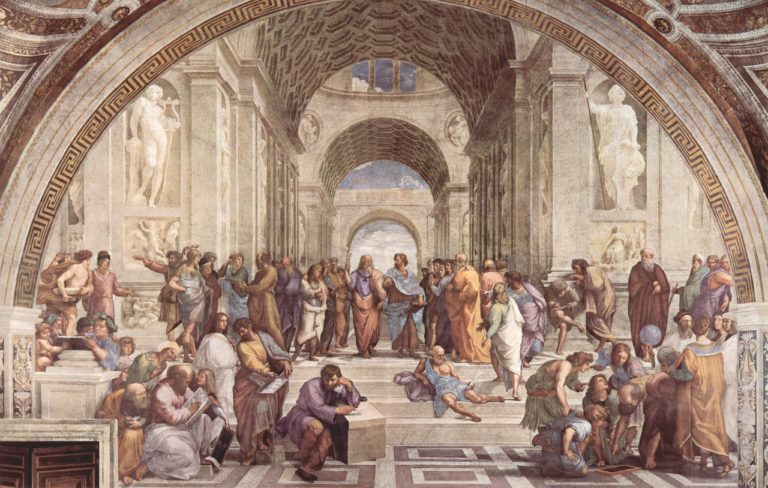
Academics at St. Martin’s are a mix of tradition and innovation. This brief post offers some perspective on our methods and rationale. It serves to frame our educational approach and should make clear the difference that St. Martin’s enacts in high school education. There is much more to follow, but for now, welcome to a school program with a difference.
Φύσις and θεωρία are words from Ancient Greek that have a long and rich (if somewhat convoluted) history of usage especially in philosophical discourse. Φύσις (physis) is a cognate of our words physics and physical, and over the millennia it has variously meant origin, nature, elementary substance, and physical shape. It appears in Homer, Aristotle, and Paul’s letters to name just a few. θεωρία (theoria) is the source of our word “theory” and its meaning is generally associated with a kind of seeing or vision. θεωρία can mean a spectacle, beholding, or contemplation. Considered in a specifically educational context, Φύσις represents the physical or practical—the things we actually do or make with our bodies. θεωρία, on the other hand, is more abstract. It consists of conventional academic work: thinking, imagining, and seeing with the mind’s eye.
Much of contemporary educational practice effects a divorce between these two integral parts of the human being and experience.
I’d like to propose that much of contemporary educational practice effects a divorce between these two integral parts of the human being and experience. I’ve talked with many adult men who described their high school years as an exercise in boredom where they spent seven hours a day staring out a classroom window at the world outside in which they longed to be—the physical world of Φύσις. Inside the classroom was, for them, pure abstraction, pure θεωρία, which in the physical vacuum increasingly implemented by hyper-technologized classrooms simply left those boys cold. Many high-schoolers receive an education that focuses solely on standardized test and college preparation. This focus often leaves students critically underdeveloped in respect to capabilities and character traits that are essential to happiness and success throughout life regardless of college attendance. To be clear, our students will be more than capable of the world’s best universities, but our method looks a little different. There is a growing need for secondary education that addresses the whole student, physically, mentally, and spiritually in an effort to prepare the student for a life well lived. St. Martin’s seeks to meet this challenge head-on by implementing an academic program that involves thinking and doing—it is a holistic curriculum that integrates the intellectual work of classes with physical participation and work, striving to serve each student in his entirety. This approach posits that the physical and the intellectual are not opposed, but are intertwined and mutually supportive.St. Martin’s seeks to meet this challenge head-on by implementing an academic program that involves thinking and doing—it is a holistic curriculum that integrates the intellectual work of classes with physical participation and work, striving to serve each student in his entirety.
In fact, this educational vision is rooted in a Catholic anthropology. How and what one teaches has to correspond to the truth of the person being taught, and our vision reflects the Church’s teaching that “the rational or intellectual soul is… per se and essentially the form of the human body,” This means that for us, θεωρία and Φύσις, thinking and being, mind and body are properly inseparable. The estrangement of thinking from being is a bifurcation of the inherent capacities and responsibilities of the human being and effects what Owen Barfield calls a “sword thrust between spirit and matter” that damages both, inhibiting the growth of the person in accordance with his nature. St. Martin’s responds to this problem by offering an integrated education. Students studying chemistry will be cultivating plants whose health depends on sound chemistry. Students reading the Iliad will carry logs over difficult terrain making the poetry a personal experience. Our practicum in astronomy will be a site of intersection for geometry, orienteering, and history. High Mass on Sunday will demand proficiency in chant and polyphony—knowledge of music activated to make music—not to mention representing a perfection of the union of thinking and being, of word and flesh. We invite you to review our Curriculum Overview and to check back regularly for additional information and posts on our academic program, farming operation, and liturgical life, and how they all fit together. In the meantime, here are just a few of the books that we have found instrumental in determining our vision.- The Catechism of the Catholic Church
- What is True Education – Fr. Edward Leen
- The Idea of a University – Bd. John Henry Cardinal Newman
- Beauty in the Word – Stratford Caldecott
- Restoration of Innocence and The Restoration of Christian Culture – John Senior
- The Love of Learning and the Desire for God – Jean Leclercq O.S.B.
- Shop Class as Soulcraft – Matthew Crawford
- Saving the Appearances – Owen Barfield

